OAXACA.
CENTER OF OAXACA
Because of its beautiful colonial buildings, the city has been classified as Cultural Heritage of Humanity.
 SANTO DOMINGO TEMPLE
SANTO DOMINGO TEMPLE
Its construction was completed in 1608, it is one of the most important examples of the Mexican Baroque style. Its altar is a wonderful piece finely carved wood covered with gold leaf.
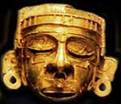 MUSEUM OF CULTURES OF OAXACA
MUSEUM OF CULTURES OF OAXACA
Inside of this museum there are rooms of ethnography, religious art and archeology, where is one of the most important prehistoric treasures of America, Tomb 7 of Monte Alban.
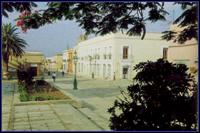 ANDADOR TURÍSTICO
ANDADOR TURÍSTICO
It is a green stone pedestrian street which have many colonial buildings and galleries, restaurants and artesanias shops.. The people can walk and visit all this shops.
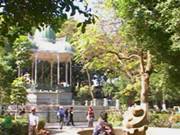 ZÓCALO
ZÓCALO
This beautiful park is the social center of the city, in the afternoon the marimba band plays lively tunes state in its "central kiosk". Vendors, students, tourists and Oaxacan make it a lively place and the place just to sit and enjoy the day.
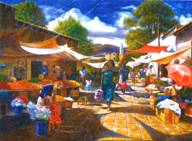 BENITO JUÁREZ MARKET
BENITO JUÁREZ MARKET
Oaxaca offers a great cultural variety, and market mix of aromas and flavors achieved it a spectacular image. You can purchase products such as chocolate, bread, Oaxaca cheese, different varieties of moles. You also can appreciate fine ceramics, textiles, wooden toys, masks, etc.
 MONTE ALBÁN:
MONTE ALBÁN:
The state of Oaxaca was conducive to the establishment and development of one of the most important ceremonial first cities in Mesoamerica territory: Monte Alban, founded around the year 300 A.C. The site is located ten kilometers from the state capital, the buildings rise on top of a mountain, almost two thousand meters above sea level. Monte Alban was a political and ceremonial city whose strategic location allowed the Zapotec dominate the valley and its surroundings: this group conquered vast territories they play areas of what is now known as Oaxaca, Puebla, Guerrero, Chiapas and Veracruz. Of the conquered places they created a confederation of peoples who were ruled by a priestly and military oligarchy.
It originated approximately between 700 and 500 BC, but the earliest human settlements had reached the valley of Oaxaca centuries ago.
MITLA - TULE – TEOTITLÁN DEL VALLE - HIERVE EL AGUA
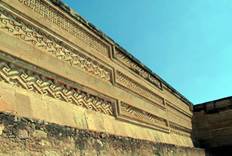 MITLA:
MITLA:
The archaeological site and the present town are Zapotec, Mitla was inhabited from the classical period (100-650 AD.) Reaching its maximum growth and height in the post classic (750-1521 AD.) Period. The main attraction of the archaeological zone of Mitla is undoubtedly the varied ornamentation of its buildings, achieved through the system of frets that distinguishes it from the rest of the country.
South Group, Adobe Group, the Arroyo Group, the Columns Group and Church Group: five groups of buildings known as appreciate. The first two sets are classified as ceremonial, consisting of mounds and central squares, the other three are classified as organized palaces with rooms around quadrangular courtyards.
 ARBOL EL TULE:
ARBOL EL TULE:
Among the natural beauties of Oaxaca, one of the most extraordinary is the giant and unique Sabino called "The Tule Tree". It has a height of 40 mts., A diameter of 52.58 meters. and weighing 509 tons and about 2000 years old. Ubicated in the town of Santa Maria El Tule, the children there may give us a guide to the "figures" (capricious forms of the tree itself that the locals have christened with names of animals, people, etc.) that can be displayed on the majestic tree.
 TEOTITLÁN DEL VALLE:
TEOTITLÁN DEL VALLE:
Zapotec village of Teotitlan del Valle have a long history in the textile art. This place is characteristic for the tissue and creating original and colorful carpets of 100% virgin wool. The intense hues that appear in the rugs come from plants, fruits and insects. The bright red color is obtained from the “Grana cochinilla”. Blue comes from the plant of indigo; huatle the yellow, dry moss; Ambers of a lichen that grows on the rocks; the black pod acacia and brown is obtained from the nutshell.
EXCURSION: Barro negro, mercado indígena, textiles y alebrijes.
The village where crafts of black mud, a village where we see a women's cooperative that produce cotton textiles, the place where the colorful alebrijes are made and a church of the XVI century are elaborated.
 SAN BARTOLO COYOTEPEC:
SAN BARTOLO COYOTEPEC:
This town has a well-earned reputation in the world of Mexican crafts, and occupies an important place among the most prized and sought popular ceramics in the country. It's easy to recognize by its burnished bright spot and intense black color. In fact, it is known as "black mud of Oaxaca".
 SAN MARTIN TILCAJETE:
SAN MARTIN TILCAJETE:
Here we will visit some families who are engaged in the production of carved wooden figures, better known as alebrijes. The local persons give us a demonstration of his work.
 OCOTLÁN:
OCOTLÁN:
Here we visit a beautiful church of the XVI century which was restored by Rodolfo Morales Cultural Foundation.
SANTO TOMAS JALIETZA:
In this village there is a cooperative of women artisans engaged in the production of cotton textiles using the technique of loom, as was done in the pre-Hispanic times. Some products are individual for table cloths, belts, purses, etc.














